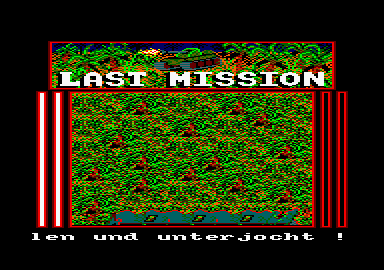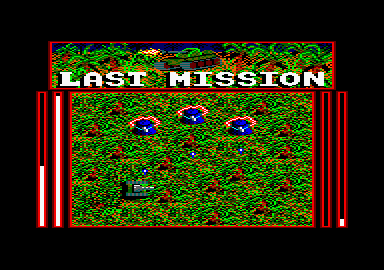After finishing my Ghostbusters hommage "Ghosthunters" I tried several different new ideas. "Last Mission" unfortunately was the only one that ever got finished.
I still remember how the idea to create a tank fighting game developed over the time. It started, believe it or not, as a motorcycle racing game!In the Summer of 1988 my parents took us kids (hey, I was 16 at that time!) to Lake Garda in Italy for two weeks. We spent the time at a camping site at the lake and there wasn't much to do besides swimming and spending our time in a small arcade close by.   
There I discovered a motorcycle racing game. It was a vertical scrolling game with a 2D birdseye view. The first level was in some kind of desert and besides the road there were just sand dunes, cactuses and shrubbery. I never spent any money on this game, but I watched other kids play it and I though to myself 'Well this doesn't look to hard to convert to CPC'. As soon as I was back in Germany I started working on this game. I painted some elements for a desert like different types of dunes, some plants and an abandoned house. But I soon had to figure out that vertical scrolling wasn't one of CPCs strenghtes (or I wasn't able to create a proper and fast vertical scrolling...). So I gradually switched over to the idea of creating a tank game. I think I was playing some tank game during that time (maybe Ikari Warriors?) and I always got annoyed when my tank was blocked by some stupid small fence, tree or wall. I thought that a tank would be able to drive through virtually anything. Therefore I decided to create a tank game in which you were able to smash anything you wanted to. I started creating my usual BASIC - Assembler mishmash and somehow messed up the collision detection, but I didn't care this much about whether or not you have to hit some obstacle exactly or not for as long as it got flattened. You can also run over the shadows of the ruin and destroy these - I obviously didn't have the time or programming skills to fix the destroy-everything routine, so that you could run over shadows without destroying them. Or maybe I didn't wanted to create a subroutine that figures out whether the tank ran over the wall and thus its shadow had to be removed from the screen. I was very proud on the fact that the chains of the tank left permanent tracks on the ground. The more you drive around in a picture, the more tracks you leave and the ground is more and more destroyed. But as you can easily see I overdid the colorfulness of the graphics a little. You can barely see your tank on all the green background and the palm trees look like some brown dirt on the screen, since you cannot discern the palm leaves from the background. I also wrote a nice level editor - man, I loved creating level editors! - and while I was lost in hacking in levels, I went way over my Kilobyte limit and had to end the levels quickly in order to still be able to send this program to the CPC International (a famous German CPC magazine), hoping that they would accept it and it would be printed in their magazine. I obviously also made some cutbacks on the story development... (It's just a typical 'the last human being has to defeat the evil aliens from outta space to safe the earth' story). But at least I've included a real ending sequence! (I always hated games without any ending sequence or just some stupid congratulations-text and I swore to myself never to create a game without an appropriate ending!). The programming itself is very crappy. When you go a little deeper into it you'll surely find out that I've kept a square double buffer image of the actual playing screen in the second screen buffer (&4000 - &7FFF). For some reason I didn't think of creating a double buffer in one continuous memory block, so that I had to copy the lines from the continous double buffer into the square playing screen. This would have been a lot less trouble. But in all my early works I use double buffer images with the same size and form like the actual playing screens (e.g. in "Enchanted Forest") The game ended up being published on the "CPC International Databox" (a Tape/ Disc which came with the monthly magazine) and I got some 500 German Marks for it (which was really a lot - and which I almost immediatley spent on a large number of CPC games... :-). ODIESOFT
ruin and destroy these - I obviously didn't have the time or programming skills to fix the destroy-everything routine, so that you could run over shadows without destroying them. Or maybe I didn't wanted to create a subroutine that figures out whether the tank ran over the wall and thus its shadow had to be removed from the screen. I was very proud on the fact that the chains of the tank left permanent tracks on the ground. The more you drive around in a picture, the more tracks you leave and the ground is more and more destroyed. But as you can easily see I overdid the colorfulness of the graphics a little. You can barely see your tank on all the green background and the palm trees look like some brown dirt on the screen, since you cannot discern the palm leaves from the background. I also wrote a nice level editor - man, I loved creating level editors! - and while I was lost in hacking in levels, I went way over my Kilobyte limit and had to end the levels quickly in order to still be able to send this program to the CPC International (a famous German CPC magazine), hoping that they would accept it and it would be printed in their magazine. I obviously also made some cutbacks on the story development... (It's just a typical 'the last human being has to defeat the evil aliens from outta space to safe the earth' story). But at least I've included a real ending sequence! (I always hated games without any ending sequence or just some stupid congratulations-text and I swore to myself never to create a game without an appropriate ending!). The programming itself is very crappy. When you go a little deeper into it you'll surely find out that I've kept a square double buffer image of the actual playing screen in the second screen buffer (&4000 - &7FFF). For some reason I didn't think of creating a double buffer in one continuous memory block, so that I had to copy the lines from the continous double buffer into the square playing screen. This would have been a lot less trouble. But in all my early works I use double buffer images with the same size and form like the actual playing screens (e.g. in "Enchanted Forest") The game ended up being published on the "CPC International Databox" (a Tape/ Disc which came with the monthly magazine) and I got some 500 German Marks for it (which was really a lot - and which I almost immediatley spent on a large number of CPC games... :-). ODIESOFT
|  [WMG!
[WMG!